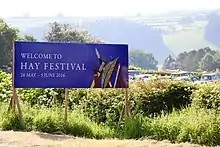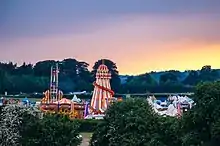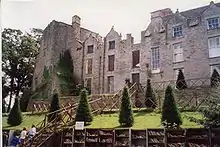Hay-on-Wye
Hay-on-Wye (Welsh: Y Gelli Gandryll or just Y Gelli), often abbreviated to just "Hay" (the community uses the short version) is a small market town and community in the historic county of Brecknockshire (Breconshire) in Wales, currently administered as part of the unitary authority of Powys.[2] With over twenty bookshops, it is often described as "the town of books", and is both the National Book Town of Wales and the site of the annual Hay Festival.
Hay-on-Wye
| |
|---|---|
 A second-hand bookshop | |
 Hay-on-Wye Location within Powys | |
| Population | 1,598 (2011)[1] |
| OS grid reference | SO225425 |
| Community |
|
| Principal area | |
| Ceremonial county | |
| Country | Wales |
| Sovereign state | United Kingdom |
| Post town | HEREFORD |
| Postcode district | HR3 |
| Dialling code | 01497 |
| Police | Dyfed-Powys |
| Fire | Mid and West Wales |
| Ambulance | Welsh |
| UK Parliament | |
| Senedd Cymru – Welsh Parliament | |
The settlement's name is first referred to between 1135 and 1147 as Haya; in 1299 the name of La Haye is used. By the 16th century it was simply called Hay, and the use of the river as a suffix is a later addition. In 1215, a Welsh name, Gelli was recorded, and Gelli gandrell in 1614; the two names may have been used concurrently in 1625. The English language name, Hay, is derived from Old English hæg, possibly meaning a "fenced area" and a noun used in late Saxon and Norman times for an enclosure in a forest. The Welsh word celli (lenited to Gelli) has a range of meanings including wooded areas of various extents.[3]
The population of the town in 1841 was 1,455.[4] This had grown to 1,680 by 1901. The Town's size has not changed much since, with 2018 estimates at 1900. The built-up area includes Cusop over the border and has a population of around 2,000.[5]
Book town


Hay-on-Wye is a destination for bibliophiles in the United Kingdom, still with two dozen bookshops, many selling specialist and second-hand books,[6] although the number has declined sharply in recent years, many becoming general antique shops and similar.[7] Hay-on-Wye was already well known for its many bookshops before the festival was launched. Richard Booth opened his first shop there in 1962, and by the 1970s Hay had gained the nickname "The Town of Books".
Hay Festival
Since 1988, Hay-on-Wye has been the venue for an annual literary festival, now sponsored by The Daily Telegraph newspaper, which draws a claimed 80,000 visitors over ten days at the end of May or beginning of June to see and hear big literary names from all over the world. Devised by Norman, Rhoda and Peter Florence in 1988, the festival was described by Bill Clinton in 2001 as "The Woodstock of the mind". Tony Benn said: "In my mind it's replaced Christmas". Peter Florence continues to be director of the Festival.
In 2019, the Festival was reported to have directly generated £83 million for Hay-On-Wye's economy over the previous ten years.
In earlier years, the festival was held at a variety of venues around Hay, including the local Primary School. In 2005 it moved to a unified location at the west of the town, with classical music concerts held in St Mary's Church.
Location
The town lies on the south-east bank of the River Wye and is within the north-easternmost tip of the Brecon Beacons National Park, just north of the Black Mountains. The town is just on the Welsh side of the border with Herefordshire, England, here defined by the Dulas Brook. Where the brook joins the River Wye just north of the town, the border continues northwards along the river. The Wye was the boundary between the former counties and districts of Radnorshire and Brecknockshire.
The adjacent village of Cusop lies on the English side of the Dulas Brook. The nearest city is Hereford, county town of Herefordshire, some 22 miles (35 km) to the east.
The Royal Mail depot in Hay is a sub-office of Hereford, and therefore although in Wales has an English postal address, being part of the HR3 postcode.

Governance
Hay-on-Wye is a Welsh community with a Town Council. Its boundary follows the English border/Dulas Brook from the River Wye southeastwards for just over a kilometre, turns south-west to a point just south of Oakfield house, thence north to Greenpit Farm and north westwards, enclosing the Hay Showground and meeting the National Park boundary near the B4350, Brecon Road. From this point, it follows the National Park boundary to the River Wye and the river back to the Dulas Brook.[8]
The Town Council consists of a Mayor, Deputy Mayor and eight councillors.[9]
Hay also participates in the election of a councillor to Powys County Council as part of a larger county division.
Transportation
The B4350 runs through the town and the B4351 links it with the main A438 from Brecon to Hereford, on the far side of the River Wye. The town was formerly served at Hay-on-Wye railway station by the train services which closed in 1963 under the Beeching Axe.
There is a semi-regular bus that links Hay to Brecon (and then Cardiff) and to Hereford.
Other activities
Hay Golf Club (now defunct) was founded in 1903. The club continued on its nine-hole course until the onset of World War 2.[10]
The town's football club is called Hay St. Mary's, and they currently play in the Spar Mid Wales League First Division.
Hay was named one of the best places to live in Wales in 2017.[11]
HowTheLightGetsIn Festival

Hay also hosts the world’s largest philosophy and music festival, HowTheLightGetsIn, which occurs annually in Hay-on-Wye in May. HowTheLightGetsIn attracts a footfall of over 30,000 each year. It aims "to get philosophy out of the academy and into people's lives" by bringing together philosophers, writers, academics, comedians and musicians for a festival of debate, talks, music, workshops, and late night parties.
Speakers at the festival have included Noam Chomsky, Brian Eno, Kimberlé Crenshaw, Philip Pullman, Diane Abbott, Steven Pinker and Laurie Penny, among others. Music headliners have included Clean Bandit, Hot Chip, and Donovan. Comedians have included James Acaster, Sarah Pascoe, and Phil Wang.
History
Hay-on-Wye, like Builth Wells, has two Norman castles within a short distance of each other. It seems likely that Hay was first fortified by William Fitz Osbern during his penetration of south-east Wales in the summer of 1070, when he defeated three Welsh kings. The history of the site then continues through the lordships of the de Neufmarchés, which was confirmed at the Battle of Brecon in 1093, and also the Gloucester/Hereford families until 1165, when the district of Brycheiniog passed into the hands of the de Braose dynasty of Marcher Lords. In 1230 Hay Castle passed to the de Bohuns and the local history, including the battle near Hay in 1231, is continued through the Mortimer Wars of the 1260s and the battle near Brecon in 1266 down to the death of Earl Humphrey de Bohun in 1298.
First castle
Lying close to St Mary's Church on the western edge of Hay-on-Wye is a small but well-preserved motte. The site overlooks a gorge and small stream, locally known as The Loggin Brook, that flows into the River Wye, which was undoubtedly one reason for the construction of a motte and bailey castle there. A recently levelled platform under the car park to the north east may have once have housed the castle's bailey. This little fortress was probably the work of William Revel, a knight of Bernard de Neufmarché who is usually referred to as Bernard Newmarch, and may later have been the seat for the manor or commote of Melinog. Other than this, the motte has no further recorded history.
Stone castle
The main fortress within Hay-on-Wye was situated on the great site commanding the town and river under the current ruins of the castle and mansion. This was undoubtedly the 'castello de haia' handed to Miles of Gloucester, 1st Earl of Hereford, in 1121 with Sibyl de Neufmarché, the daughter of Bernard de Neufmarché. It is most likely that the keep stood by this time. It is therefore possible that this is the oldest Norman tower in Wales, dating to the onslaught of William Fitz Osbern in 1070. During the anarchy (1136–54) in the reign of King Stephen a series of charters were passed by the Gloucesters concerning the castle. In 1165 the last of Miles of Gloucester's male descendants was killed at nearby Bronllys Castle and Hay-on-Wye Castle passed into the hands of William de Braose, 3rd Lord of Bramber and of New Radnor and Buellt. The de Braose dynasty were energetic lords and probably built the core of the gatehouse which now stands besides the keep. In the summer of 1198 a major English army formed here before marching off to victory at the Battle of Painscastle some four miles to the north.
In 1230 the last de Braose of Brecon, William de Braose was hanged by Prince Llywelyn ab Iorwerth and Brecon lordship with Hay-on-Wye passed into the hands of the de Bohuns. Taking advantage of this in 1231, Prince Llywelyn ravaged the lands of his de Bohun in-laws during which Hay-on-Wye town was burnt, although the castle survived the onslaught. The castle saw service in the Barons' War of 1263 to 1266, changing hands three times, once being surrendered to the great Simon de Montfort, 6th Earl of Leicester. With the conquest of Wales by King Edward I Longshanks life became more peaceful in this Marcher town.
Around 1401 both town and castle suffered damage by the forces of Owain Glyndŵr, although the castle was listed as defensible against the Welsh in 1403. The fortress later passed to the earls of Stafford, who were to become the unlucky dukes of Buckingham during the Wars of the Roses. The castle was repaired during the conflicts of the 1460s, although its military use would have been somewhat dubious against cannon.
In the 1660s, James Boyle of Hereford built a new mansion on the north side of the castle, and most of the curtain wall was demolished to improve the views. The mansion is now used for second-hand bookselling.
Remains of castle

The keep is roughly thirty feet (9.1 m) square, and once had four storeys. The corners of the tower have been much rebuilt, probably due to insecure foundations. The entire south east corner of the tower has been replaced and it is possible that when first constructed there was a spiral stair here to allow access to the upper floors. This tower is similar to the keep found at Goodrich Castle.
Some time in the 12th century the strong curtain wall with gate was added to the site. This gateway is one of the finest carved castle gateways in Wales and is comparable with the much more ornate work at Newcastle near Bridgend. The two gates hanging within the gateway, although of different ages, would appear to be very old — the gates at Chepstow Castle have been dendrochronologically dated to the reign of King Henry II (1154–89).
Probably during the troubles of the Barons' War a small tower was added in front of the gateway to make a proper gatehouse complete with portcullis. The portcullis mechanism mounted on the wall walk was reached via a flight of steps up over the back of the gate passageway, which also allowed access to the wall walks.
Hay-on-Wye has a Victorian clock tower (below right); there is an identical twin clock tower in Knighton, Powys.

Notable buildings
Hay has nearly 150 listed buildings, including the Castle, St Mary's parish church, St John's chapel, the Ebenezer United Reformed Church, the Swan Hotel, and part of the Town Hall, as well as many of the town centre inns and shops. [12]
The Butter Market was built in the form of a Doric temple in 1833 by William Enoch: the Cheese Market was built in 1835 for Sir Joseph Bailey; both are on the site of the 17th century market house.
Cockcroft House on Union Mews is the former workhouse. It was built in 1837 for the Hay Poor Law Union which was formed on 26th September 1836.
The Harley Almshouses, 1 Brecon Road, were built and endowed by Frances Harley in 1836 in memory of her sister Martha Harley of Trebarried.
The former vicarage for St Mary's church is on the corner of Church Street and Oxford Road. Rock House on Broad Street was built as the manse to the 1845 Ebenezer Chapel.
Oakfield is a Grade II listed Regency house located south of the town centre: built in about 1820, it was recorded in 1842 as the home of Henry Allen Junior. [13]
Twinning
Hay-on-Wye is twinned with Redu, a village in the Belgian municipality of Libin, and with Timbuktu, Mali, West Africa.[14]
King of Hay-on-Wye

On 1 April 1977, bibliophile Richard Booth conceived a publicity stunt in which he declared Hay-on-Wye to be an 'independent kingdom' with himself as its monarch and a National Anthem written by Les Penning. The tongue-in-cheek micronation of Hay-on-Wye has subsequently developed a healthy tourism industry based on literary interests for which some credit Booth.[15] In 2005, Booth announced plans to sell his bookshop and move to Germany; on this occasion local MP Roger Williams was quoted as saying "His legacy will be that Hay changed from a small market town into a mecca for second-hand book lovers and this transformed the local economy".[16]
Notable people
- Herbert Rowse Armstrong, the "Hay Poisoner" – the only UK solicitor to have been hanged for murder
- Richard Booth, self-proclaimed "King of Hay"
- Jason "J" Brown, singer in boy band Five
- Christopher Dawson, author
- Jasper Fforde, author, the Thursday Next series
- Josie Pearson, Paralympian athlete and Gold Medal winner at the 2012 Paralympic Games
- Jenny Valentine, author of Finding Violet Park
- Penelope Chetwode, Lady Betjeman, author of Two Middle-Aged Ladies in Andalucia, wife of poet laureate Sir John Betjeman and mother of journalist and writer Candida Lycett Green and Paul Betjeman, lived at New House, a cottage on Cusop Hill above Hay-on-Wye.
- Iain Finlayson, author
- Terry Pratchett, author
References
- "Ward/Town population 2011". Retrieved 11 November 2015.
- "Town/Community Council Clerks Details". Powys County Council. Retrieved 6 April 2014.
- "hay-on-Wye" (PDF). Historic Settlement Survey – Brecon Beacons National Park. Clwyd–Powys Archaeological Trust. Retrieved 6 April 2014.
- The National Cyclopaedia of Useful Knowledge, Vol III, (1847) London, Charles Knight, p.766.
- https://www.nomisweb.co.uk/reports/localarea?compare=K05000002
- Hay-on-Wye booksellers. Retrieved on 2008-05-04.
- Retrieved on 2013-05-23
- "Community and Town Council Boundaries". One Voice Wales. Archived from the original on 2 March 2014. Retrieved 6 April 2014.
- "List of Hay Town Council". Hay-on-Wye Town Council. Retrieved 6 April 2014.
- "Hay Golf Club", "Golf’s Missing Links".
- "These towns have been named as the best places to live in Wales". Wales Online.
- "Listed Buildings in Hay, Powys". British Listed Buildings.
- "Oakfield, Hay-on-Wye". British Listed Buildings.
- Hay-on-Wye is twinned with Timbuktu , BBC News, 7 February 2007, 15:53 GMT, accessed 8 February 2007.
- "Richard Booth". bbc.co.uk. Retrieved 11 May 2007.
- "Self-styled king of Hay sells up". bbc.co.uk. 18 August 2005. Retrieved 11 May 2007.
Further reading
- Remfry, P.M., Hay on Wye Castle, 1066 to 1298 (ISBN 1-899376-07-0)
External links
| Wikimedia Commons has media related to Hay-on-Wye. |
| Wikivoyage has a travel guide for Hay-on-Wye. |
| Wikisource has the text of the 1911 Encyclopædia Britannica article Hay (Breconshire). |
